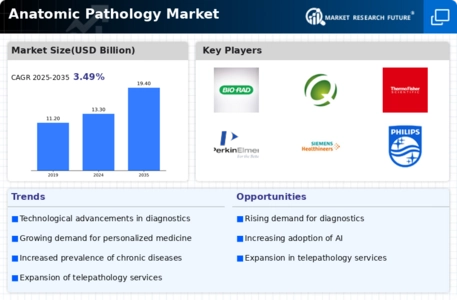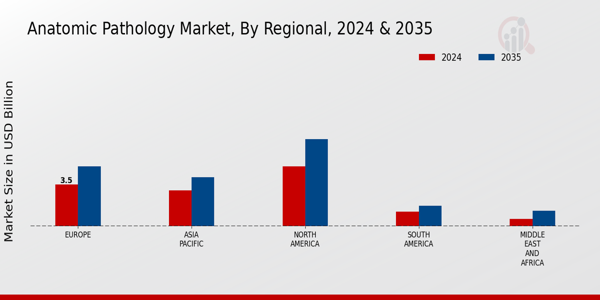Market Growth Projections
The Global Anatomic Pathology Market Industry is projected to experience robust growth in the coming years. By 2024, the market is expected to reach 13.3 USD Billion, with further expansion anticipated as it approaches 19.4 USD Billion by 2035. This growth trajectory indicates a compound annual growth rate of 3.49% from 2025 to 2035. Such projections reflect the increasing demand for anatomic pathology services driven by advancements in technology, rising chronic disease prevalence, and the push for personalized medicine. The market's expansion is likely to create new opportunities for stakeholders and enhance the overall quality of healthcare services.
Increased Healthcare Expenditure
Rising healthcare expenditure globally contributes to the growth of the Global Anatomic Pathology Market Industry. Governments and private sectors are investing more in healthcare infrastructure, leading to improved access to diagnostic services. For instance, countries are allocating larger budgets to healthcare, which facilitates the acquisition of advanced pathology equipment and training for professionals. This increased funding allows for the expansion of pathology laboratories and services, ultimately enhancing patient care. As healthcare spending continues to rise, the market is expected to benefit from these investments, supporting its growth trajectory in the coming years.
Rising Incidence of Chronic Diseases
The Global Anatomic Pathology Market Industry experiences growth driven by the increasing prevalence of chronic diseases such as cancer, cardiovascular disorders, and diabetes. As these conditions become more common, the demand for accurate diagnostic tools and pathology services rises. For instance, the World Health Organization indicates that cancer cases are expected to increase by 70 percent over the next two decades. This trend necessitates advanced anatomic pathology services to ensure timely and accurate diagnoses, thereby propelling the market's expansion. With the market projected to reach 13.3 USD Billion in 2024, the focus on chronic disease management is likely to remain a key driver.
Regulatory Support and Standardization
Regulatory support and standardization in the Global Anatomic Pathology Market Industry play a crucial role in ensuring quality and consistency in diagnostic services. Governments and health organizations are implementing guidelines and regulations that promote best practices in pathology. This regulatory framework not only enhances the reliability of diagnostic results but also fosters innovation in pathology services. As laboratories adhere to these standards, they are likely to gain accreditation, which can improve their market competitiveness. The emphasis on regulatory compliance is expected to drive the growth of the market, as stakeholders seek to meet the evolving demands of healthcare systems.
Growing Demand for Personalized Medicine
The shift towards personalized medicine is a pivotal factor in the Global Anatomic Pathology Market Industry. As healthcare moves away from one-size-fits-all approaches, the need for precise diagnostic information becomes paramount. Anatomic pathology plays a crucial role in identifying biomarkers that guide treatment decisions tailored to individual patients. This trend is reflected in the increasing investment in genomic and molecular pathology, which enhances the understanding of disease mechanisms. The market's projected CAGR of 3.49% from 2025 to 2035 suggests that the demand for personalized diagnostic services will continue to rise, further driving the industry forward.
Technological Advancements in Diagnostic Tools
Technological innovations in diagnostic tools significantly influence the Global Anatomic Pathology Market Industry. The integration of digital pathology, artificial intelligence, and machine learning enhances the accuracy and efficiency of diagnostic processes. For example, digital pathology allows pathologists to analyze high-resolution images remotely, improving workflow and collaboration. As these technologies evolve, they are expected to reduce diagnostic errors and expedite results, which is crucial in clinical settings. The anticipated growth of the market to 19.4 USD Billion by 2035 underscores the importance of these advancements in shaping the future of anatomic pathology.




















